Attached files
| file | filename |
|---|---|
| 8-K - 8-K - EMC INSURANCE GROUP INC | a2016summerinvestorpresent.htm |
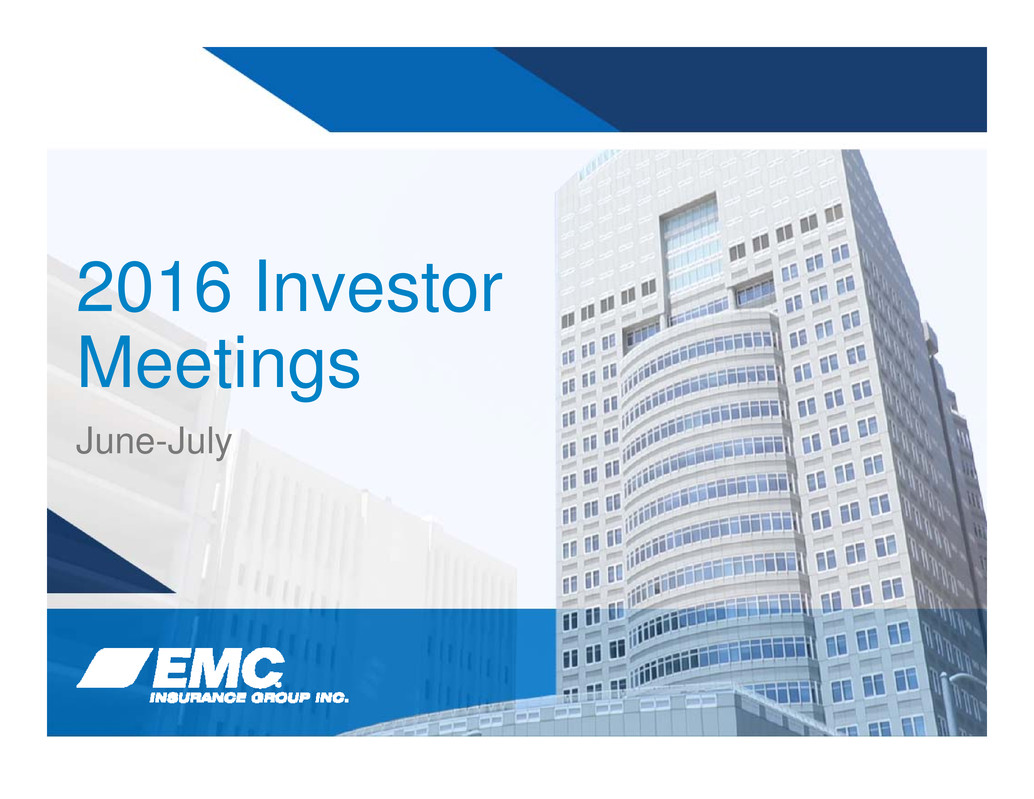
1 2016 Investor Meetings June-July
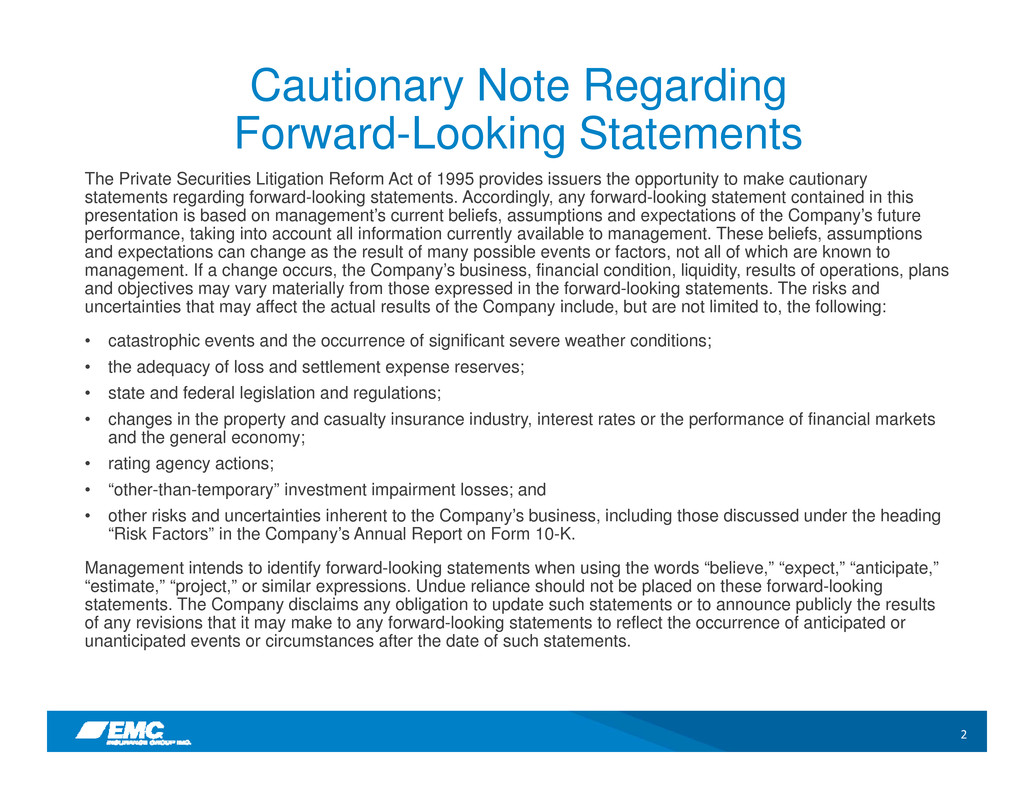
2 Cautionary Note Regarding Forward-Looking Statements The Private Securities Litigation Reform Act of 1995 provides issuers the opportunity to make cautionary statements regarding forward-looking statements. Accordingly, any forward-looking statement contained in this presentation is based on management’s current beliefs, assumptions and expectations of the Company’s future performance, taking into account all information currently available to management. These beliefs, assumptions and expectations can change as the result of many possible events or factors, not all of which are known to management. If a change occurs, the Company’s business, financial condition, liquidity, results of operations, plans and objectives may vary materially from those expressed in the forward-looking statements. The risks and uncertainties that may affect the actual results of the Company include, but are not limited to, the following: • catastrophic events and the occurrence of significant severe weather conditions; • the adequacy of loss and settlement expense reserves; • state and federal legislation and regulations; • changes in the property and casualty insurance industry, interest rates or the performance of financial markets and the general economy; • rating agency actions; • “other-than-temporary” investment impairment losses; and • other risks and uncertainties inherent to the Company’s business, including those discussed under the heading “Risk Factors” in the Company’s Annual Report on Form 10-K. Management intends to identify forward-looking statements when using the words “believe,” “expect,” “anticipate,” “estimate,” “project,” or similar expressions. Undue reliance should not be placed on these forward-looking statements. The Company disclaims any obligation to update such statements or to announce publicly the results of any revisions that it may make to any forward-looking statements to reflect the occurrence of anticipated or unanticipated events or circumstances after the date of such statements.

3 Table of Contents Page/Slide Number Who We Are 4 Key Reasons to Invest in EMCI 5 Award-Winning Workplace 6 Corporate Structure 7 Benefits of Pooling Agreement 8 Benefits of Quota Share Agreement with EMCC 9 2015 Premiums Earned 10 Diversified Book of Business 11-12 2015 Direct Written Premiums by Branch (CL) 13 Local Service Focus 14 Value of Local Market Presence 15 2015 Premium Distribution by Account Size (CL) 16 Strength in Group Programs 17 Unique and Powerful Rate Compare System 18 Commercial Rate Changes Outpace Industry 19 Page/Slide Number Selected Financial Results 20 GAAP Combined Ratios 21 Loss Cost Trend 22 Investment Portfolio 23 Fixed Income Portfolio 24 Stockholder Dividends 25 Maximizing Stockholder Value 26 New in 2016 27 2015 Direct Written Premiums by State (PL) 28 Agency Differentiation Through Telematics 29 Benefits of Telematics 30 2016 Intercompany Reinsurance Programs 31-32 Attractive Returns for Stockholders 33 Improving Valuation 34 Appendix 35-37
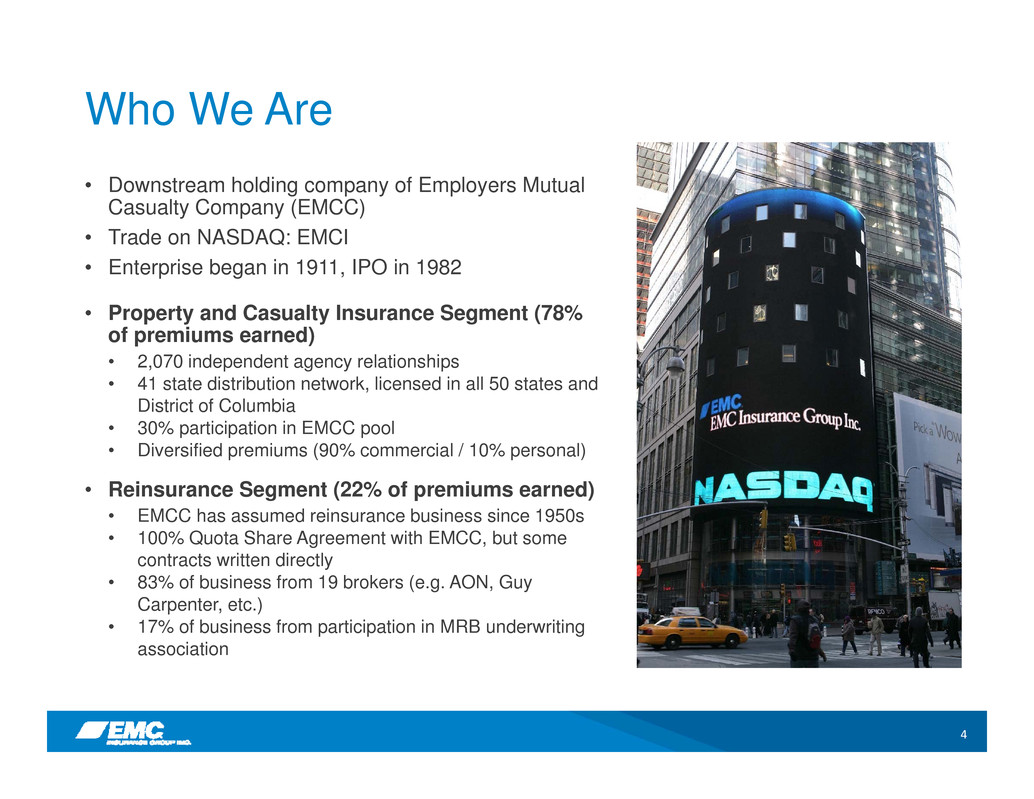
4 • Downstream holding company of Employers Mutual Casualty Company (EMCC) • Trade on NASDAQ: EMCI • Enterprise began in 1911, IPO in 1982 • Property and Casualty Insurance Segment (78% of premiums earned) • 2,070 independent agency relationships • 41 state distribution network, licensed in all 50 states and District of Columbia • 30% participation in EMCC pool • Diversified premiums (90% commercial / 10% personal) • Reinsurance Segment (22% of premiums earned) • EMCC has assumed reinsurance business since 1950s • 100% Quota Share Agreement with EMCC, but some contracts written directly • 83% of business from 19 brokers (e.g. AON, Guy Carpenter, etc.) • 17% of business from participation in MRB underwriting association Who We Are

5 Key Reasons to Invest in EMCI • Proven ability to deliver attractive returns to shareholders: • Dividend yield of 2.9% as of May 26, 2016 • Access to large capital base • Diversified, seasoned book of business • Regional, decentralized operating structure • Conservative balance sheet • Experienced senior management *Source: Bloomberg as of March 31, 2016 1-Year 3-Year 5-Year Total Stockholder Return* 17.2% 16.9% 12.9%
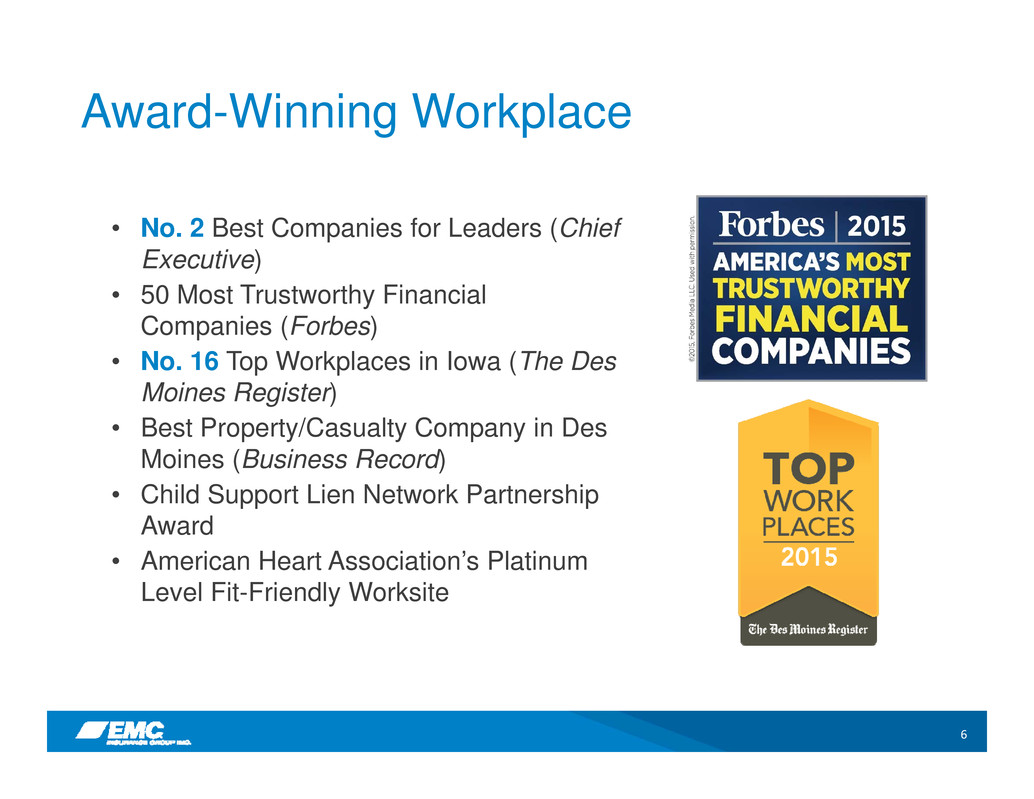
6 Award-Winning Workplace • No. 2 Best Companies for Leaders (Chief Executive) • 50 Most Trustworthy Financial Companies (Forbes) • No. 16 Top Workplaces in Iowa (The Des Moines Register) • Best Property/Casualty Company in Des Moines (Business Record) • Child Support Lien Network Partnership Award • American Heart Association’s Platinum Level Fit-Friendly Worksite

7 Corporate Structure Reinsurance Segment (100% Quota Share Agreement with EMCC) Employers Mutual Casualty Company (Founded in 1911) Public Shareholders EMC Insurance Group Inc. (IPO in 1982 - Follow-on offerings in 1985 and 2004) 56%* 44%* *Ownership as of March 31, 2016 Dakota Fire Insurance Company EMCASCO Insurance Company Illinois EMCASCO Insurance Co. EMC Reinsurance Company EMC Underwriters, LLC Property and Casualty Insurance Segment (Aggregate 30% pool participation)
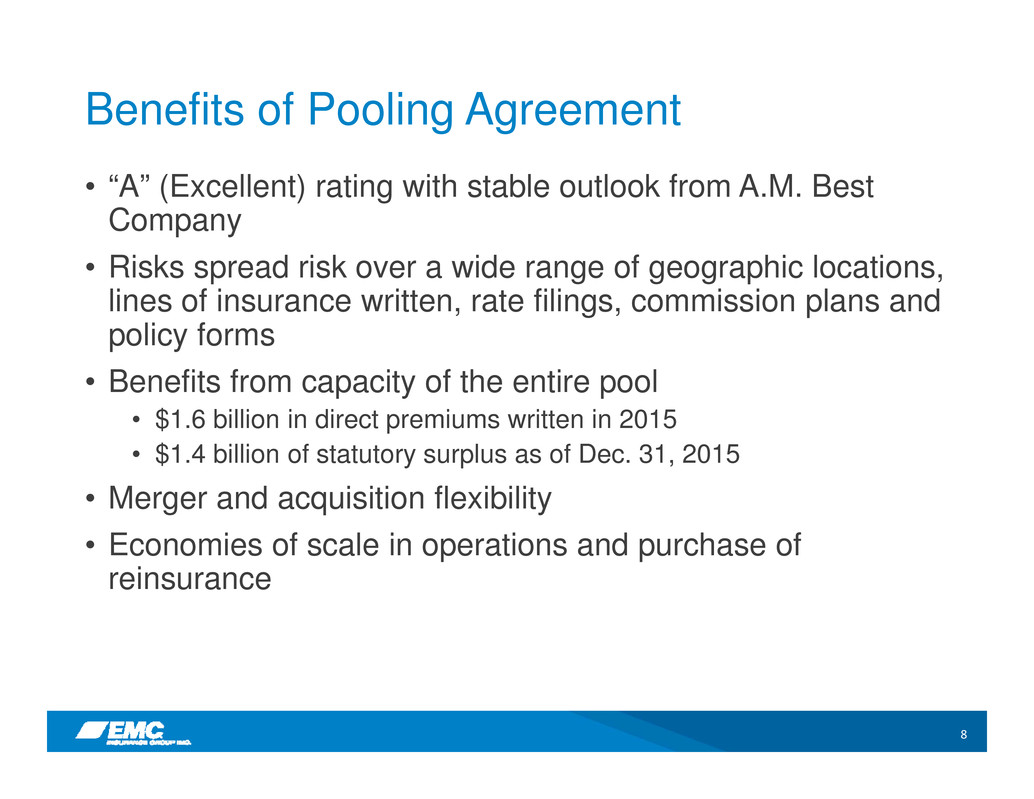
8 Benefits of Pooling Agreement • “A” (Excellent) rating with stable outlook from A.M. Best Company • Risks spread risk over a wide range of geographic locations, lines of insurance written, rate filings, commission plans and policy forms • Benefits from capacity of the entire pool • $1.6 billion in direct premiums written in 2015 • $1.4 billion of statutory surplus as of Dec. 31, 2015 • Merger and acquisition flexibility • Economies of scale in operations and purchase of reinsurance

9 Benefits of Quota Share Agreement with EMCC • EMCC’s surplus ($1.3 billion as of Dec. 31, 2015) and financial strength exhibits ability to pay claims owed to ceding companies • Name recognition and long-standing domestic and international relationships with EMCC • Competitive advantage being licensed in all 50 states and District of Columbia • Utilize EMCC’s “A” (Excellent) rating from A.M. Best Company (EMC Re also rated “A”)

10 2015 Premiums Earned Reinsurance Segment $123.1 P&C Insurance Segment $447.2 EMCC, Subs. & Affil., $1,050.2 EMCI EMC Insurance Companies premiums earned ~$1.6 billion, consists of: ($ in millions) • EMCI and its subsidiaries • Employers Mutual and its subsidiaries and affiliate

11 Diversified Book of Business Reinsurance Segment Premiums Earned Domestic 87% International (mainly Europe & Japan) 13% Property Pro Rata 12.4% Property XS 51.5% Liability XS 9.9% Multiline Pro Rata 5.8% Marine Pro Rata 3.6% Liability Pro Rata 16.8% P&C Insurance Segment $447.2 million Reinsurance Segment $123.1 million
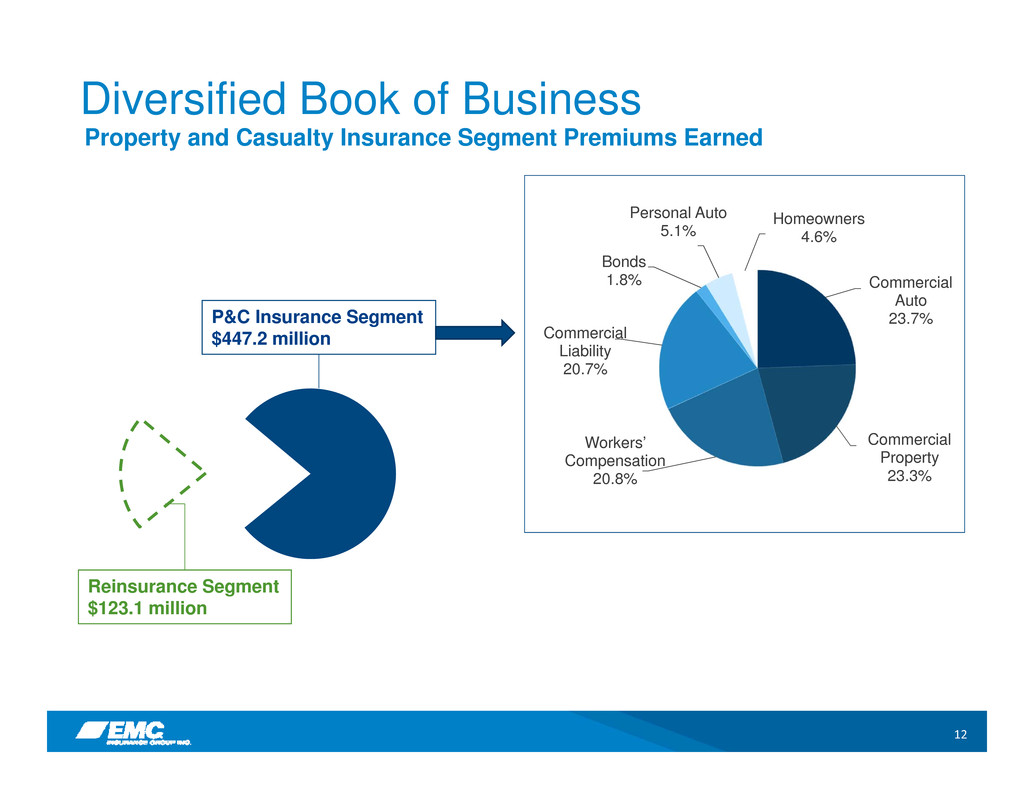
12 Reinsurance Segment $123.1 million P&C Insurance Segment $447.2 million Diversified Book of Business Property and Casualty Insurance Segment Premiums Earned Commercial Auto 23.7% Commercial Property 23.3% Workers’ Compensation 20.8% Commercial Liability 20.7% Bonds 1.8% Personal Auto 5.1% Homeowners 4.6%
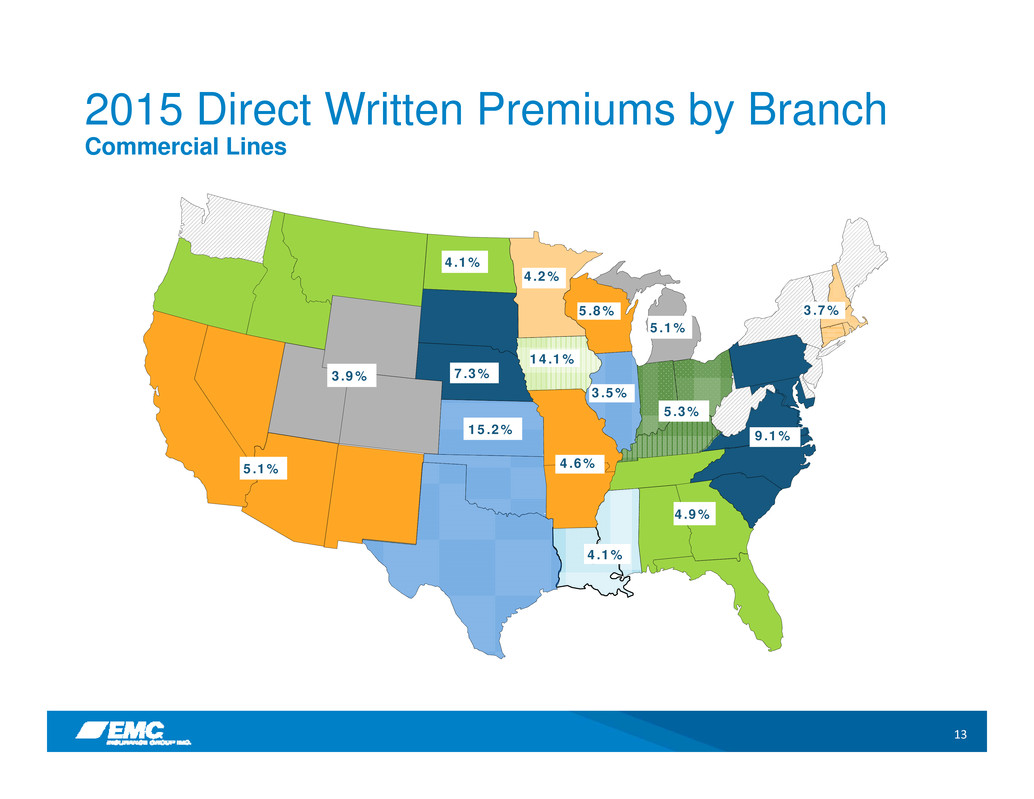
13 2015 Direct Written Premiums by Branch Commercial Lines 5.8% 4.2% 14.1% 7.3% 3.5% 4.1% 5.1% 3.9% 15.2% 4.6% 5.1% 4.1% 4.9% 5.3% 9.1% 3.7%

14 Local Service Focus Agencies Represented by Territory z68 117 141 81 133 83 96 95 73 143 120 146 91172 282 230 • Feedback from annual agent survey drives future product and service enhancements • Formal tiering program ties compensation to performance

15 Value of Local Market Presence • Decentralized Decision Making/Guided Autonomy: • Marketing • Underwriting • Risk Improvement • Claims • Strengthens agency relationships, get to quote best business generally resulting in superior loss ratio • Develop products, marketing strategies and pricing targeted to specific territories • Individual approaches within EMC risk appetite and framework • Retention levels consistently stay between 80%-90% • 86.8% at March 31, 2016
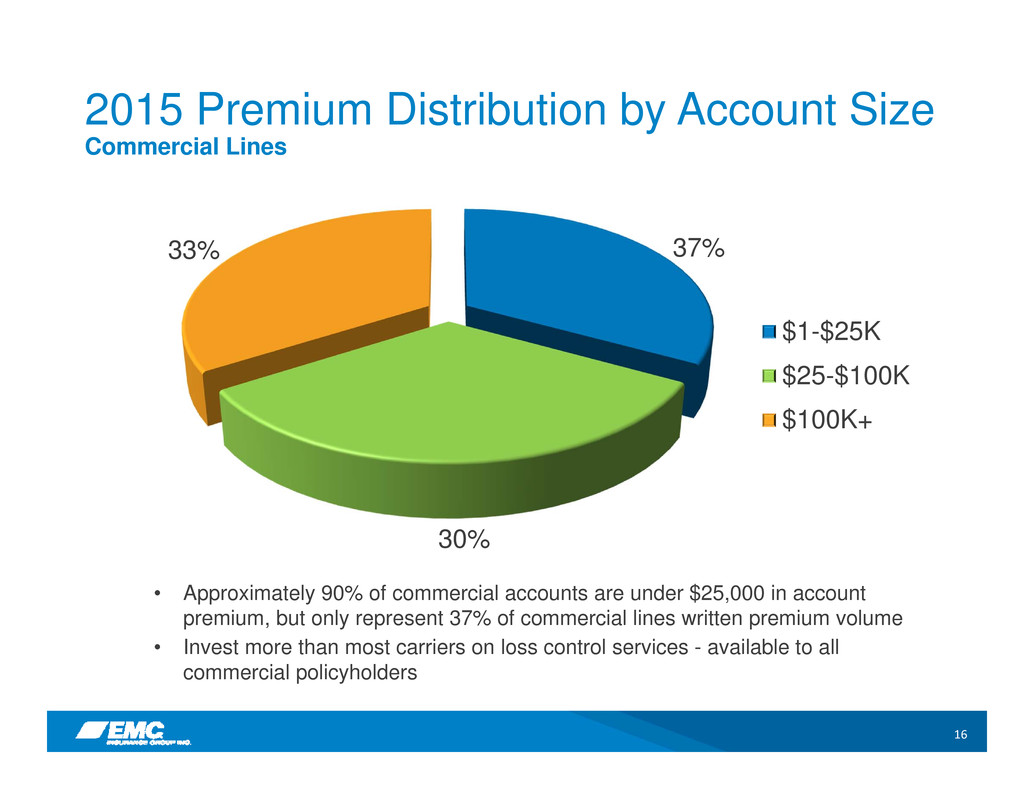
16 2015 Premium Distribution by Account Size 37% 30% 33% $1-$25K $25-$100K $100K+ • Approximately 90% of commercial accounts are under $25,000 in account premium, but only represent 37% of commercial lines written premium volume • Invest more than most carriers on loss control services - available to all commercial policyholders Commercial Lines
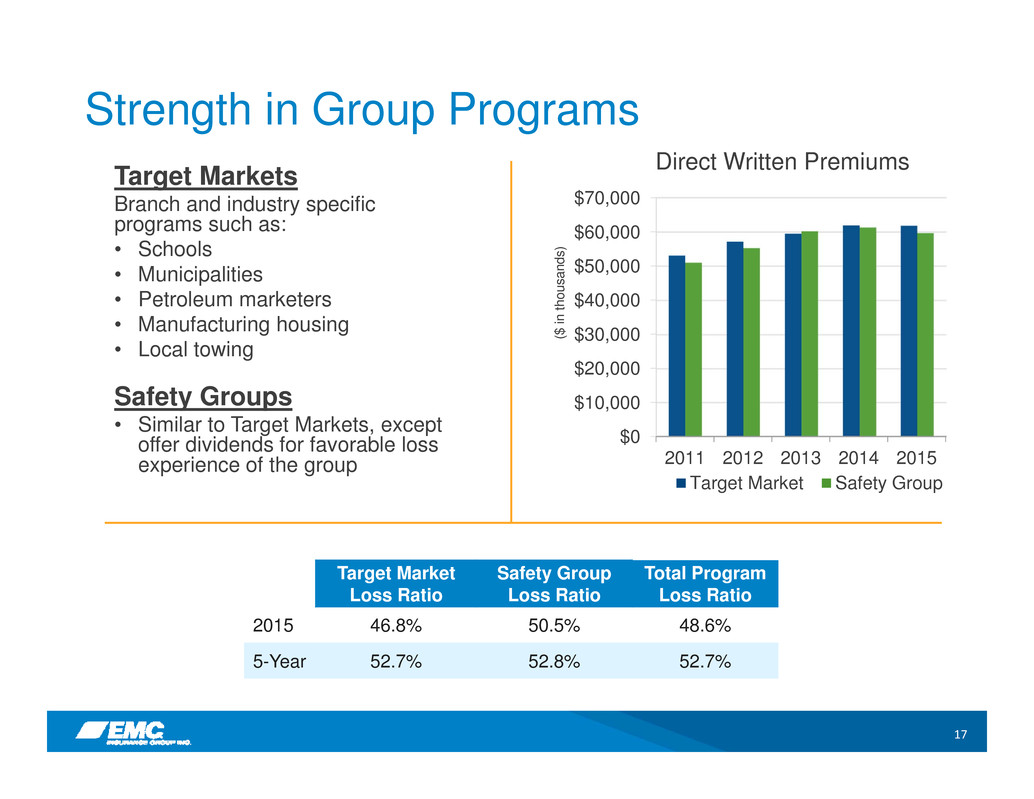
17 Strength in Group Programs Target Markets Branch and industry specific programs such as: • Schools • Municipalities • Petroleum marketers • Manufacturing housing • Local towing Safety Groups • Similar to Target Markets, except offer dividends for favorable loss experience of the group $0 $10,000 $20,000 $30,000 $40,000 $50,000 $60,000 $70,000 2011 2012 2013 2014 2015 Target Market Safety Group ( $ i n t h o u s a n d s ) Direct Written Premiums Target Market Loss Ratio Safety Group Loss Ratio Total Program Loss Ratio 2015 46.8% 50.5% 48.6% 5-Year 52.7% 52.8% 52.7%

18 Unique and Powerful Rate Compare System Rates current exposures of commercial renewal policies at current and prior period rates Provides measure of near real‐time rate increase obtained by policy, account underwriter, line of business or branch Targets specific accounts effectively for more or less rate when combined with our internal analytical models Provides accountability for our branch offices and underwriters, used in performance management to achieve desired rate level increases Rate Compare System
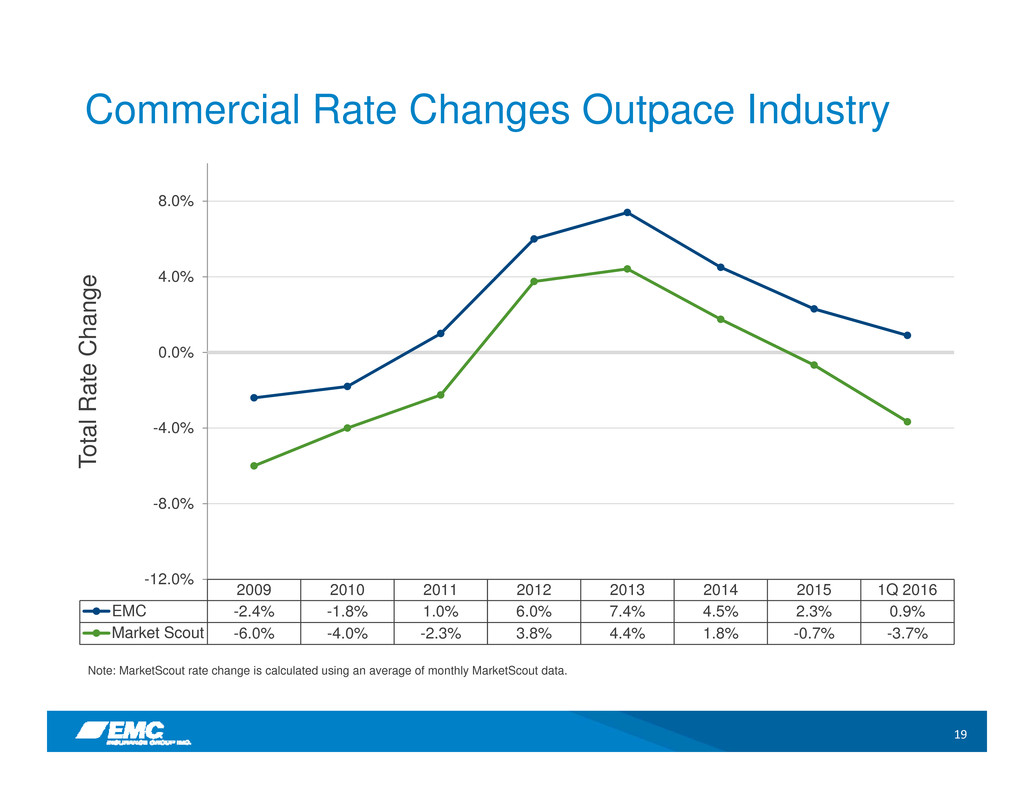
19 Commercial Rate Changes Outpace Industry Note: MarketScout rate change is calculated using an average of monthly MarketScout data. 2009 2010 2011 2012 2013 2014 2015 1Q 2016 EMC -2.4% -1.8% 1.0% 6.0% 7.4% 4.5% 2.3% 0.9% Market Scout -6.0% -4.0% -2.3% 3.8% 4.4% 1.8% -0.7% -3.7% -12.0% -8.0% -4.0% 0.0% 4.0% 8.0% T o t a l R a t e C h a n g e

20 Selected Financial Results (1) Operating income is a non-GAAP financial measure. See presentation Appendix for additional information regarding its calculation. (2) Reflects a significant reduction in the amount of pension and postretirement benefit costs allocated to the Company, as a result of a plan amendment. (3) Based on PLRB event occurrence numbers for the P&C insurance segment and PCS catastrophe serial numbers for the reinsurance segment. (4) The Company defines as losses greater than $500 for the EMC Insurance Companies pool, excluding catastrophe and storm losses. NOTE: All prior period per share amounts have been adjusted to reflect the three for two stock split completed on June 23, 2015. ($ in thousands, except per share amounts) 1Q 2016 1Q 2015 2015 2014 2013 Revenues $ 154,956 $ 151,552 $ 617,573 $ 590,118 $ 558,988 Net realized investment gains (losses) (1,085) 783 6,153 4,349 8,997 Losses and expenses (132,994) (122,398) (552,070) (553,560) (507,132) Income tax expense (6,223) (9,607) (21,494) (10,915) (17,334) Net income $ 14,654 $ 20,330 $ 50,162 $ 29,992 $ 43,519 Net income per share $ 0.70 $ 1.00 $ 2.43 $ 1.48 $ 2.22 Operating income (1) $ 15,359 $ 19,821 $ 46,163 $ 27,165 $ 37,671 Operating income per share $ 0.74 $ 0.97 $ 2.24 $ 1.34 $ 1.92 Loss and settlement expense ratio 59.6% 54.6% 65.0% 71.3% 64.7% Acquisition expense ratio 33.1% 33.1% 31.3% 30.6% 33.2% Combined ratio 92.7% 87.7% 96.3% 101.9% 97.9% After-tax per share data: Catastrophe and storm losses (3) $ (0.19) $ (0.15) $ (1.40) $ (1.84) $ (1.61) Favorable development that had an impact on earnings 0.24 0.46 1.12 0.60 0.21 Large losses (4) (0.09) (0.14) (1.08) (1.15) (0.73) (2) (2)
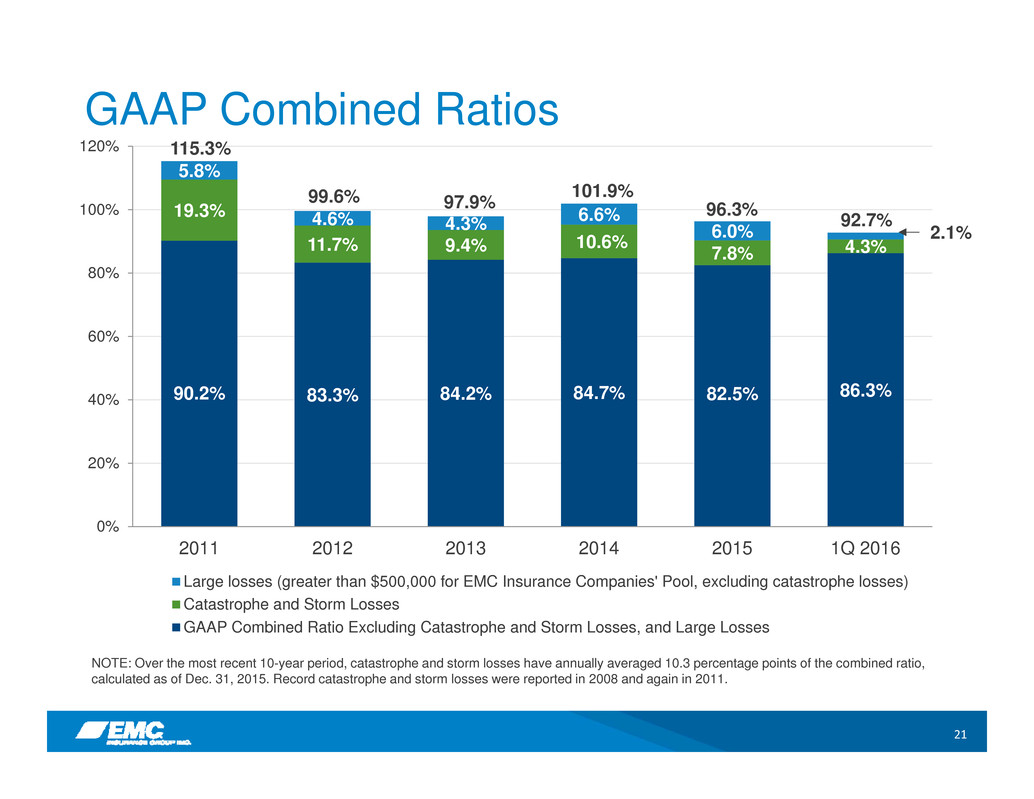
21 GAAP Combined Ratios NOTE: Over the most recent 10-year period, catastrophe and storm losses have annually averaged 10.3 percentage points of the combined ratio, calculated as of Dec. 31, 2015. Record catastrophe and storm losses were reported in 2008 and again in 2011. 90.2% 83.3% 84.2% 84.7% 82.5% 86.3% 19.3% 11.7% 9.4% 10.6% 7.8% 4.3% 5.8% 4.6% 4.3% 6.6% 6.0% 0% 20% 40% 60% 80% 100% 120% 2011 2012 2013 2014 2015 1Q 2016 Large losses (greater than $500,000 for EMC Insurance Companies' Pool, excluding catastrophe losses) Catastrophe and Storm Losses GAAP Combined Ratio Excluding Catastrophe and Storm Losses, and Large Losses 99.6% 97.9% 101.9% 92.7%96.3% 2.1% 115.3%

22 Loss Cost Trend • Provides a measure of the change in the Company’s losses • Calculated using the change in frequency of normalized claim counts and the change in severity of the claims adjusted for changes in rate levels Seven Major Lines of Direct Business Compound Ultimate Annual Trend: 2011-2016* -3.7% 5.8% 1.9% -6% -4% -2% 0% 2% 4% 6% 8% Frequency Severity Loss Cost Trend *Trend from April 1, 2011 through March 31, 2016. Excludes catastrophe and storm losses, and large losses.
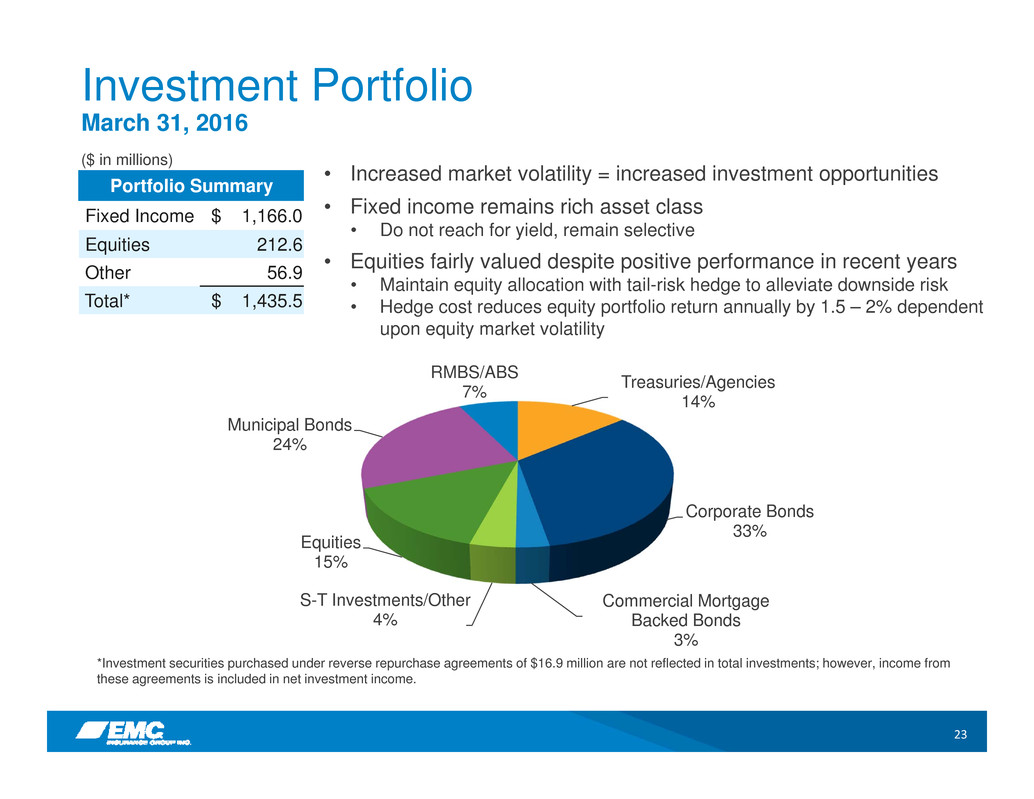
23 Investment Portfolio March 31, 2016 ($ in millions) *Investment securities purchased under reverse repurchase agreements of $16.9 million are not reflected in total investments; however, income from these agreements is included in net investment income. • Increased market volatility = increased investment opportunities • Fixed income remains rich asset class • Do not reach for yield, remain selective • Equities fairly valued despite positive performance in recent years • Maintain equity allocation with tail-risk hedge to alleviate downside risk • Hedge cost reduces equity portfolio return annually by 1.5 – 2% dependent upon equity market volatility Treasuries/Agencies 14% Corporate Bonds 33% Commercial Mortgage Backed Bonds 3% S-T Investments/Other 4% Equities 15% Municipal Bonds 24% RMBS/ABS 7% Portfolio Summary Fixed Income $ 1,166.0 Equities 212.6 Other 56.9 Total* $ 1,435.5

24 Fixed Income Portfolio March 31, 2016 4% 26% 15% 12% 15% 19% 9% Fixed Income Securities Expected Maturity Cash 0-2 Years 2-4 Years 4-6 Years 6-8 Years 8-10 Years 10+ Years Bond Ratings AAA 33.3% AA 32.3% A 27.4% BAA 6.7% BA and below 0.3% Total 100.0% Portfolio Characteristics Average Life: 4.7 Years Duration: 4.4 Pre-tax Book Yield: 3.6%

25 $- $0.05 $0.10 $0.15 $0.20 2011 2012 2013 2014 2015 2016 Quarterly Cash Dividend 1Q 2Q 3Q 4Q Stockholder Dividends • Paid dividend quarterly since IPO in 1982 • Dividend has never been reduced • Increased quarterly dividend 14% in 2015, demonstrating: • Confidence in financial condition and long- term outlook • Desire to improve total stockholder return • Dividend yield of 2.9% as of May 26, 2016
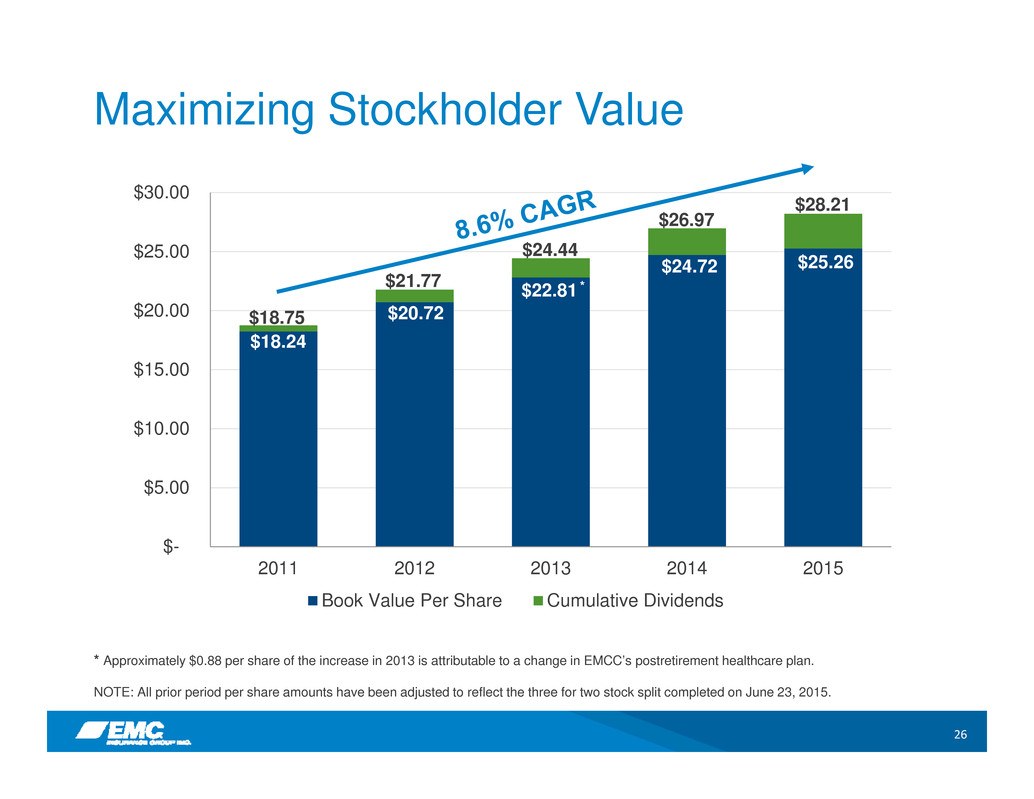
26 Maximizing Stockholder Value * Approximately $0.88 per share of the increase in 2013 is attributable to a change in EMCC’s postretirement healthcare plan. NOTE: All prior period per share amounts have been adjusted to reflect the three for two stock split completed on June 23, 2015. $18.24 $20.72 $22.81 $24.72 $25.26 $- $5.00 $10.00 $15.00 $20.00 $25.00 $30.00 2011 2012 2013 2014 2015 Book Value Per Share Cumulative Dividends $18.75 $21.77 $24.44 $26.97 $28.21 *

27 New in 2016 • Personal lines focused accountability • Agency differentiation through telematics • New and revised intercompany reinsurance agreements • Revised common stock repurchase metrics continue to focus on rate of return, but designed to provide management more discretion in stock repurchase decisions • Repurchased $380,000 of common stock in first quarter 2016 • Approximately $14.6 million remaining under $15.0 million repurchase authorization
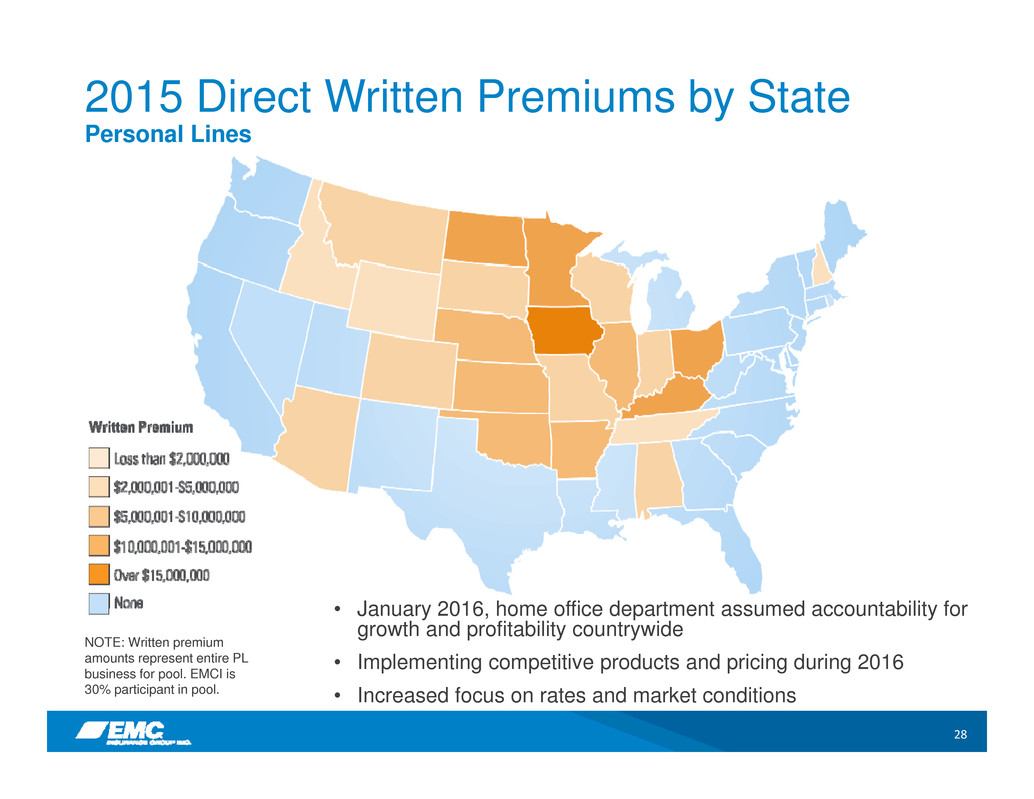
28 2015 Direct Written Premiums by State Personal Lines • January 2016, home office department assumed accountability for growth and profitability countrywide • Implementing competitive products and pricing during 2016 • Increased focus on rates and market conditions NOTE: Written premium amounts represent entire PL business for pool. EMCI is 30% participant in pool.

29 Agency Differentiation Through Telematics Agency or Company Logo Choice Manager’s App Innovative Solutions for Agents and Policyholders
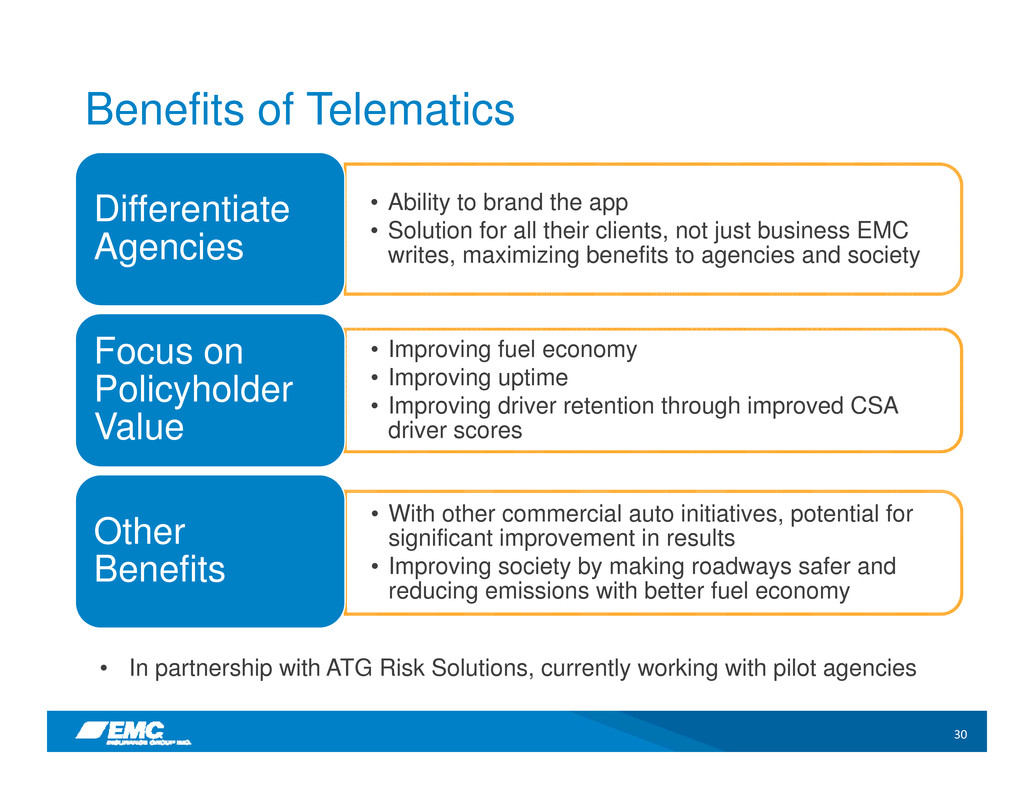
30 Benefits of Telematics • Ability to brand the app • Solution for all their clients, not just business EMC writes, maximizing benefits to agencies and society Differentiate Agencies • Improving fuel economy • Improving uptime • Improving driver retention through improved CSA driver scores Focus on Policyholder Value • With other commercial auto initiatives, potential for significant improvement in results • Improving society by making roadways safer and reducing emissions with better fuel economy Other Benefits • In partnership with ATG Risk Solutions, currently working with pilot agencies

31 2016 Intercompany Reinsurance Programs Overview • New intercompany reinsurance program between EMCI’s three insurance subsidiaries in the property and casualty insurance segment and EMCC • Revised intercompany reinsurance program between EMCI’s reinsurance subsidiary (EMC Reinsurance Company) and EMCC Objectives • Reduce volatility of EMCI’s quarterly results caused by excessive catastrophe and storm losses • Provide protection from both frequency and severity of such losses NOTE: The Inter-Company Committees of the boards of directors of EMCI and EMCC approved the terms of the agreements to ensure they are fair and equitable to both parties.
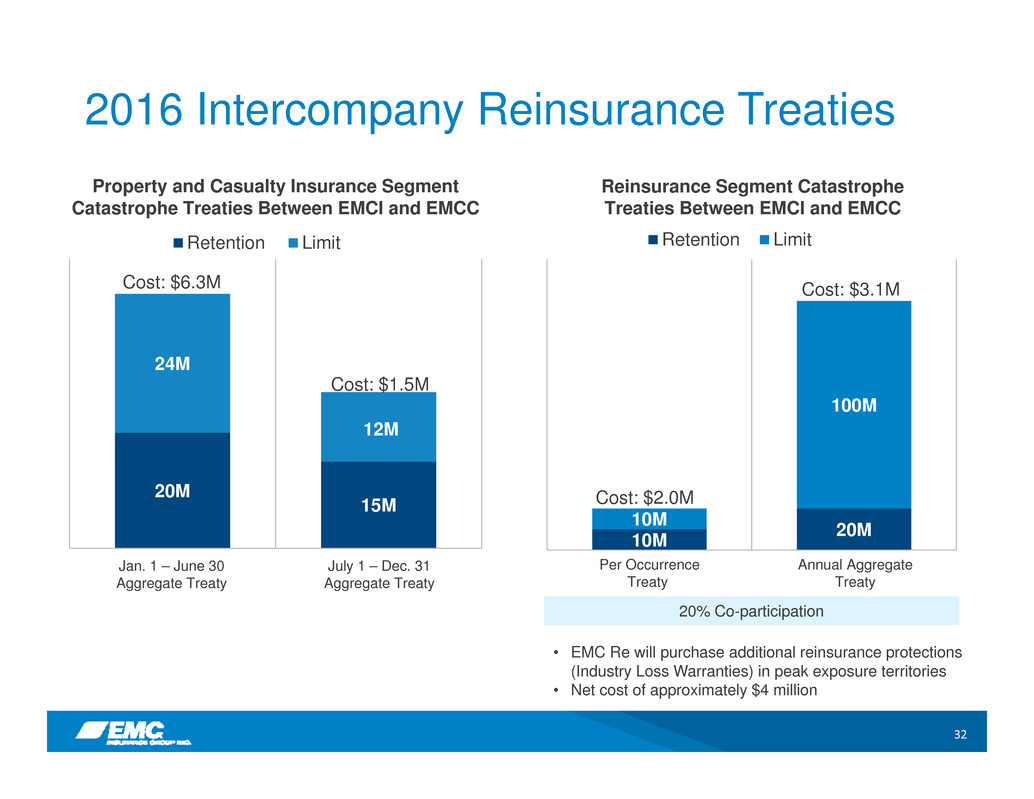
32 2016 Intercompany Reinsurance Treaties 20M 15M 24M 12M JANUARY 1 - JUNE 30 AGGREGATE TREATY JULY 1 - DECEMBER 31 AGGREGATE TREATY Retention Limit Cost: $6.3M Property and Casualty Insurance Segment Catastrophe Treaties Between EMCI and EMCC Cost: $1.5M 10M 20M 10M 100M ONE ‐T IME PER OCCURRENCE TREATY ANNUAL AGGREGATE TREATY Retention Limit Reinsurance Segment Catastrophe Treaties Between EMCI and EMCC Cost: $2.0M Cost: $3.1M Per Occurrence Treaty Annual Aggregate Treaty Jan. 1 – June 30 Aggregate Treaty July 1 – Dec. 31 Aggregate Treaty 20% Co-participation • EMC Re will purchase additional reinsurance protections (Industry Loss Warranties) in peak exposure territories • Net cost of approximately $4 million
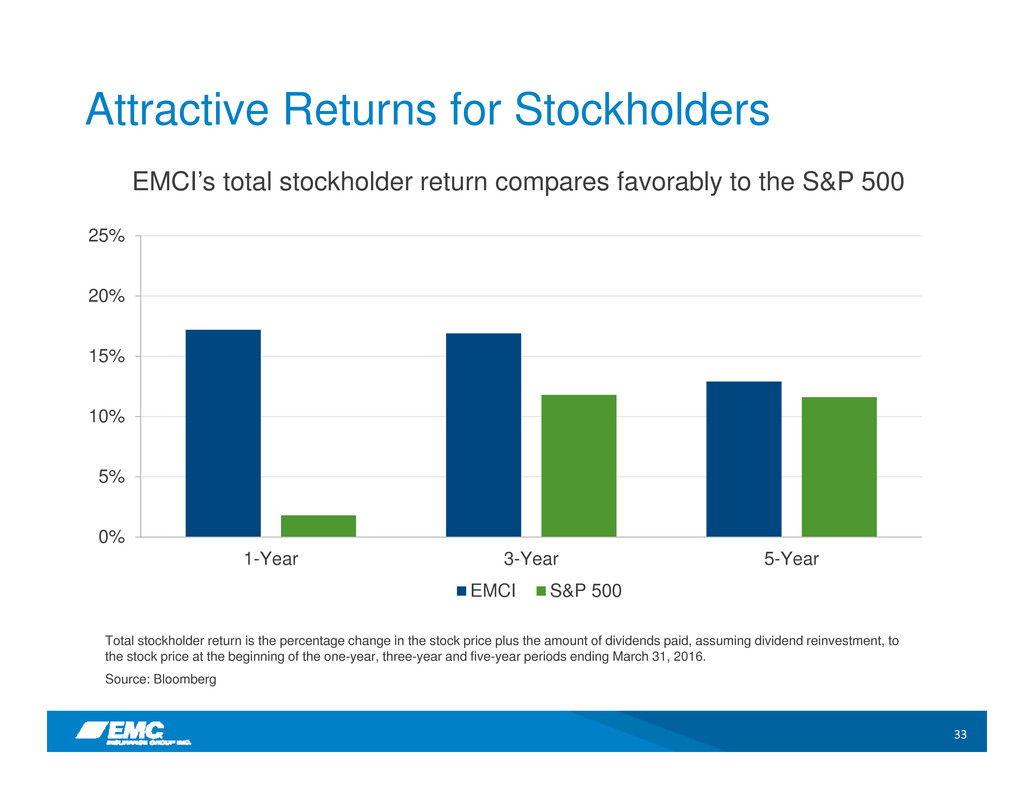
33 Attractive Returns for Stockholders EMCI’s total stockholder return compares favorably to the S&P 500 Total stockholder return is the percentage change in the stock price plus the amount of dividends paid, assuming dividend reinvestment, to the stock price at the beginning of the one-year, three-year and five-year periods ending March 31, 2016. Source: Bloomberg 0% 5% 10% 15% 20% 25% 1-Year 3-Year 5-Year EMCI S&P 500
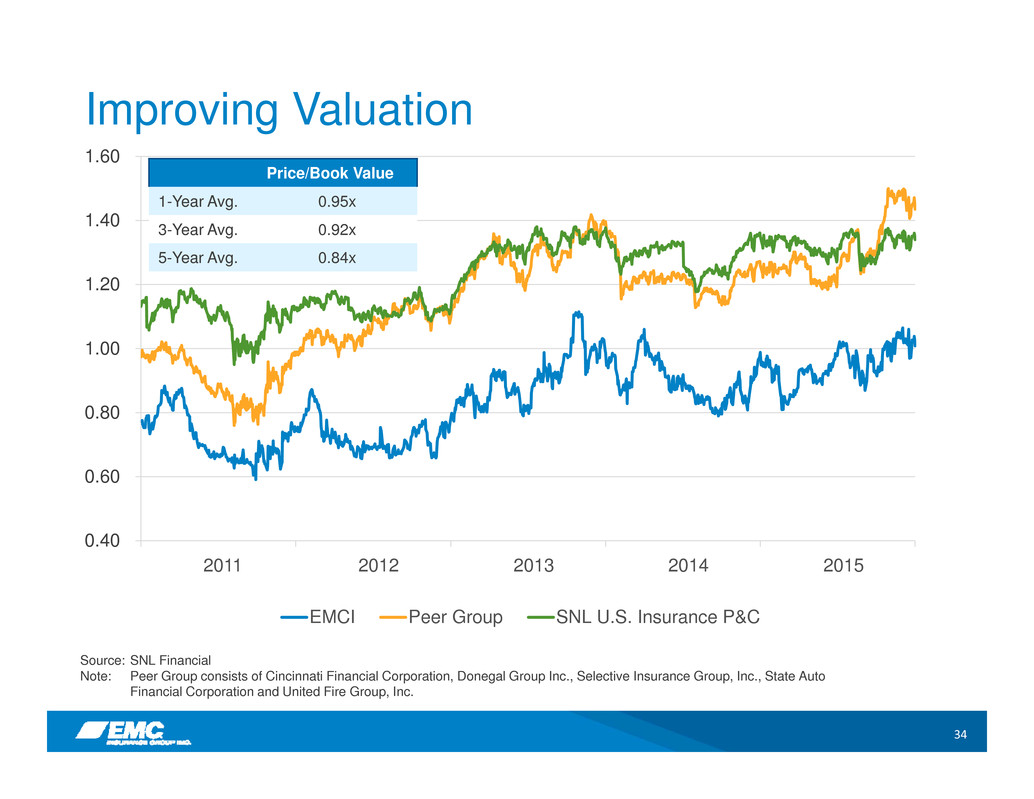
34 Improving Valuation 0.40 0.60 0.80 1.00 1.20 1.40 1.60 2010 2011 2012 2013 2014 2015 EMCI Peer Group SNL U.S. Insurance P&C Price/Book Value 1-Year Avg. 0.95x 3-Year Avg. 0.92x 5-Year Avg. 0.84x 2011 2012 2013 2014 2015 Source: SNL Financial Note: Peer Group consists of Cincinnati Financial Corporation, Donegal Group Inc., Selective Insurance Group, Inc., State Auto Financial Corporation and United Fire Group, Inc.

35 Appendix
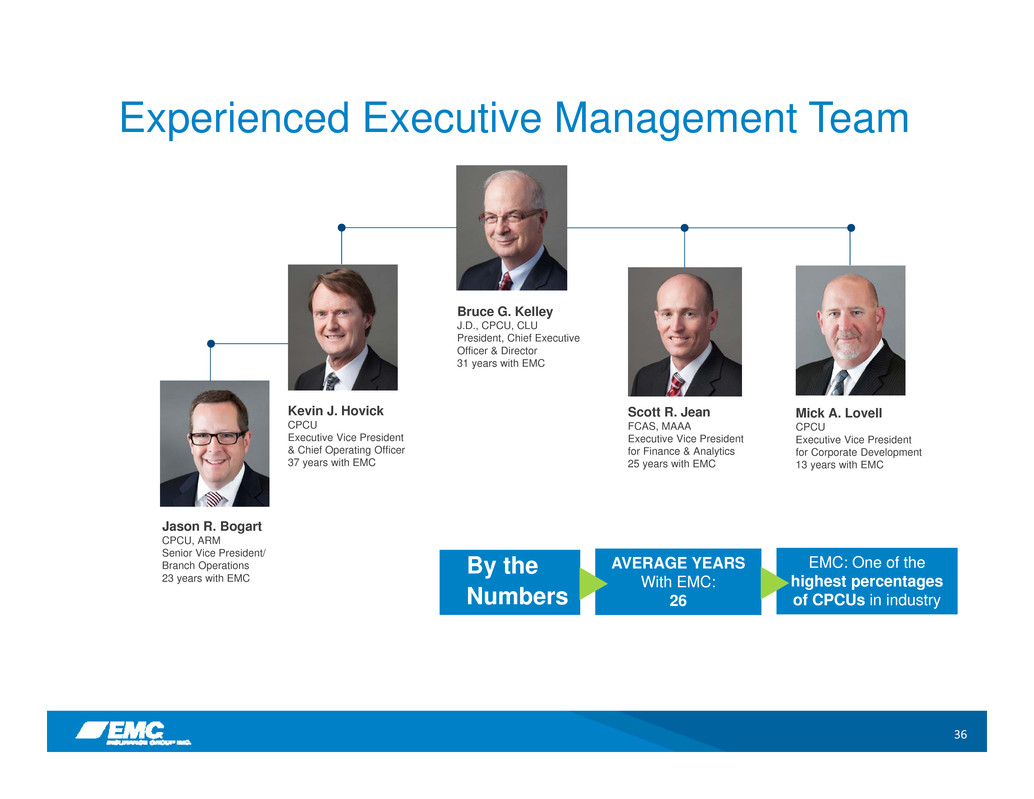
36 Kevin J. Hovick CPCU Executive Vice President & Chief Operating Officer 37 years with EMC Experienced Executive Management Team Scott R. Jean FCAS, MAAA Executive Vice President for Finance & Analytics 25 years with EMC Mick A. Lovell CPCU Executive Vice President for Corporate Development 13 years with EMC Bruce G. Kelley J.D., CPCU, CLU President, Chief Executive Officer & Director 31 years with EMC Jason R. Bogart CPCU, ARM Senior Vice President/ Branch Operations 23 years with EMC By the Numbers AVERAGE YEARS With EMC: 26 EMC: One of the highest percentages of CPCUs in industry
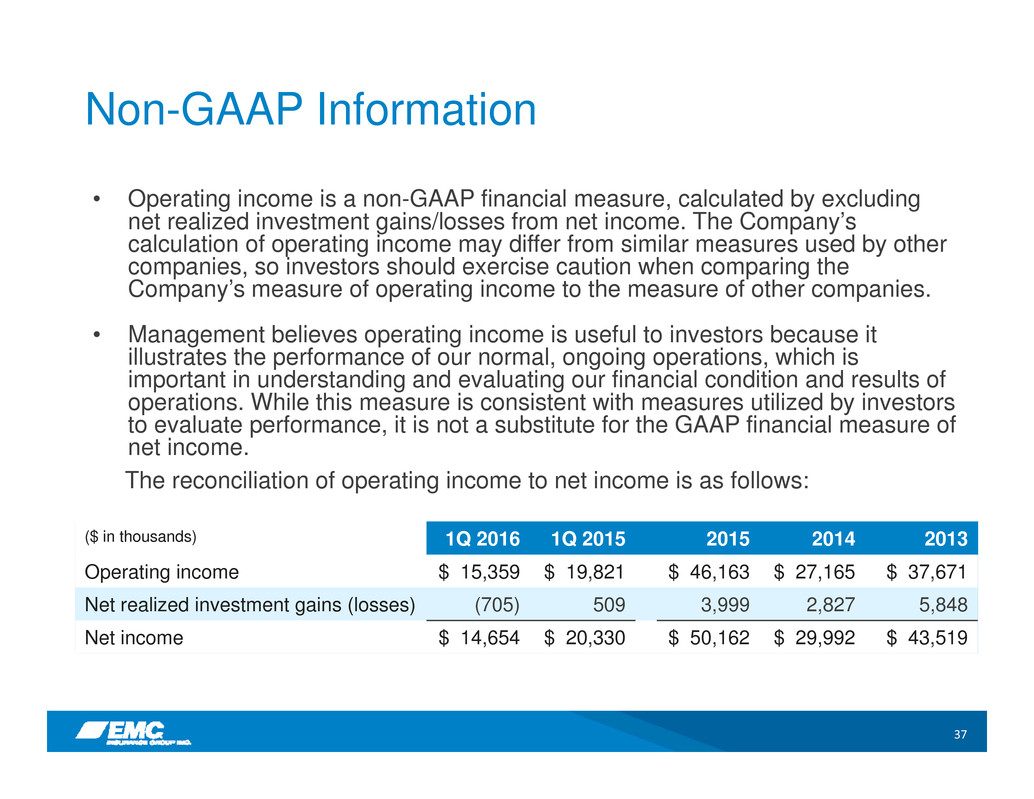
37 Non-GAAP Information • Operating income is a non-GAAP financial measure, calculated by excluding net realized investment gains/losses from net income. The Company’s calculation of operating income may differ from similar measures used by other companies, so investors should exercise caution when comparing the Company’s measure of operating income to the measure of other companies. • Management believes operating income is useful to investors because it illustrates the performance of our normal, ongoing operations, which is important in understanding and evaluating our financial condition and results of operations. While this measure is consistent with measures utilized by investors to evaluate performance, it is not a substitute for the GAAP financial measure of net income. The reconciliation of operating income to net income is as follows: ($ in thousands) 1Q 2016 1Q 2015 2015 2014 2013 Operating income $ 15,359 $ 19,821 $ 46,163 $ 27,165 $ 37,671 Net realized investment gains (losses) (705) 509 3,999 2,827 5,848 Net income $ 14,654 $ 20,330 $ 50,162 $ 29,992 $ 43,519
